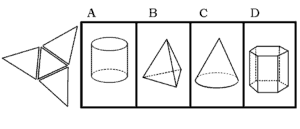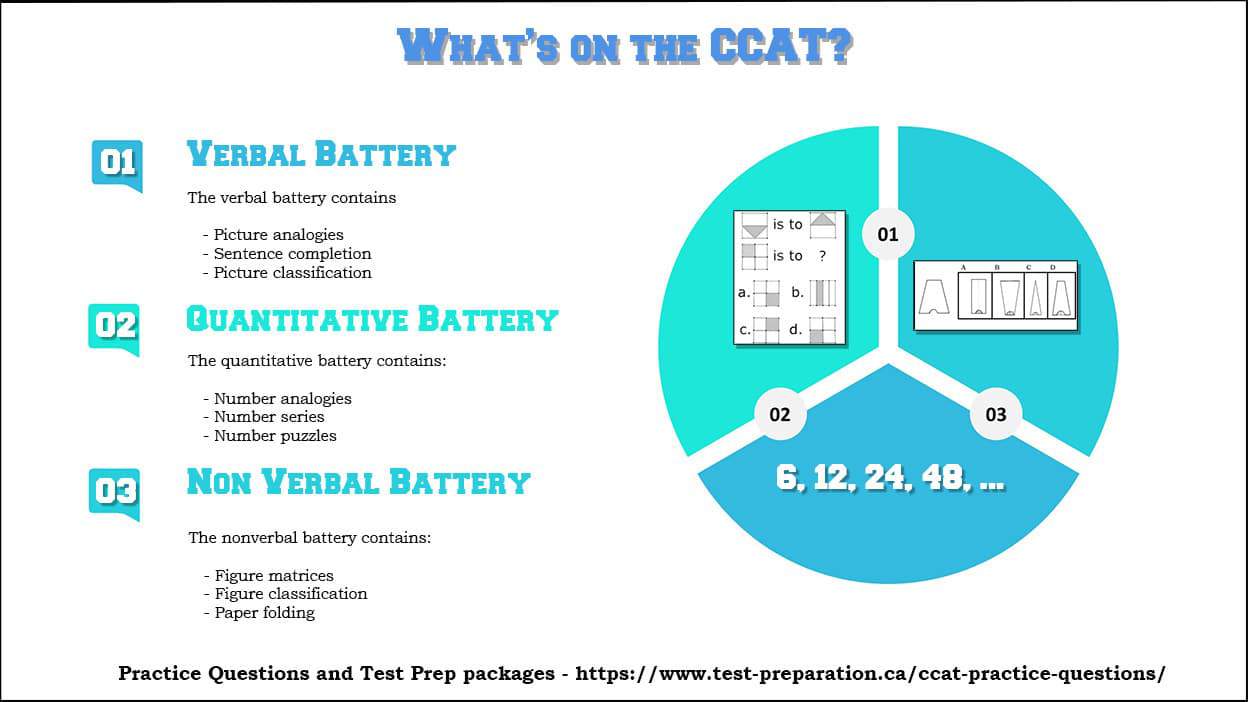CCAT Practice Test Questions and test information
- Posted by Brian Stocker
- Date November 4, 2020
- Comments 4 comments
About the test
The Canadian Cognitive Abilities Test is a cognitive test often used for admissions to gifted programs throughout Canada. It is aimed at evaluating the cognitive abilities of students in K-12 grades. The test is the Canadian version of the CogAT (Cognitive Abilities Test), which is given in the United States.
Assesses academic strengths and weaknesses in children to be admitted into Canadian gifted and talented programs n grade 1. The test assesses verbal, nonverbal, and quantitative abilities. The test focuses less on verbal abilities than nonverbal and quantitative skills, and is very useful for students who do not speak English natively.
Test Format
The CCAT is a lengthy test, and the three batteries are often given in separate testing sessions, sometimes even on different days. Administration time may vary, depending on how long the proctor takes to administer the test. Students are generally given between 30–45 minutes to complete each battery. It takes between two and three hours to complete all three batteries. In total, the CCAT has between 118 and 176 questions, depending on the level.

Scoring
Scores received are a composite of all three of the CCAT batteries with three different scores. The Age Percentile Rank (APR) ranks a student with others in his or her age group, whereas the Grade Percentile Rank (GPR) ranks a student within their grade. The final score, the Stanine (S) score, relays a specific range of scores that have predetermined ranks-—9 being very high, 1 being very low, and 4–6 being average.
You get your report immediately after you complete the test. The results and interpretations of the test can be explained using four categories:
- Raw Score
Once you take the CCAT Test, you will be provided with a raw score. A raw score indicates the number of questions answered correctly. For instance, if your raw score is 30, it means that you have correctly answered 30 out of 50 questions.
The average raw score is 24.
- Percentile Ranking
The raw score is converted into a relative performance metric called ‘percentile ranking.’ This indicates your score in comparison to others who have taken the test. For instance, if your percentile ranking is 44, it means that you scored better than 44% of test-takers.
- Sub-Scores
You also receive separate scores for each of the three sections: (1) logic and math, (2) verbal ability, and (3) spatial reasoning. The scores you receive in these categories are percentiles, meaning that if you scored a 25 in logic and math, 50 in verbal ability, and 75 in spatial reasoning:
25 = you scored better than 25% of other test-takers in logic and math
50 = you scored better than 50% of other test-takers in verbal ability
75 = you scored better than 75% of other test-takers in spatial reasoning
CCAT Test Content – All Levels
The Canadian Cognitive Abilities Test has 7 levels, one for each grade starting at kindergarten:
The test has three sections called batteries: The Verbal Battery, the Nonverbal Battery, and the Quantitative Battery. These batteries can be administered separately or together, depending on the school’s specific needs or the teacher administering the test.
The Verbal Battery tracks how students apply language to reasoning. Students are tested based on their comprehension of language structure and word relationships. Questions include verbal classification, sentence completion, and verbal analogies.
The Nonverbal Battery evaluates spatial abilities independent of language. Questions include many diagrams and visual aids. Students are asked to apply their knowledge to figure classifications, figure analogies, and figure analysis. The Nonverbal Battery measures explicitly reasoning and problem-solving abilities.
The Quantitative Battery assesses number skills. Reasoning and problem-solving skills are tracked based on mathematical ability and numerical application. Questions include quantitative relations, number series, and equation building.
CCAT practice test questions for each level below.
Verbal Battery
The verbal battery contains
- Picture analogies
- Sentence completion
- Picture classification
The verbal reasoning section tests reasoning and comprehension, and the use language for reasoning tasks.
Why Verbal Reasoning is important
- Conceptual Thinking: Verbal tasks, especially those involving classification, require your child to identify relationships between different words or concepts
- Language Proficiency: tests a child’s ability to understand, use and assimilate language. This is a critical skill and predictor of academic success, as well as daily communication and various types of interactions.
- Predictor of Academic Success: Proficiency in the verbal section is an excellent predictor of a child’s future achievements in social studies, language arts, , and related disciplines.
- Identifying Needs: The verbal section can guide teachers in instruction and intervention strategies to improve children’s language and reasoning ability.
Verbal Battery Practice
Sentence Completion (meaning in context)
Picture Analogies (IQ type)
Quantitative Battery
The Quantitative Battery assess a student’s ability to understand and analyze numerical concepts and relationships, use logical reasoning, apply mathematical concepts and solve mathematical problems, and reason using numbers. All of these cognitive skills are essential for problem-solving in many different contexts.
The quantitative battery contains:
- Number analogies
- Number series
- Number puzzles
Why the Quantitative Battery is Important
Evaluates Numerical Proficiency: The quantitate battery assesses the ability to understand, work with, and infer information based on numerical data. This is a critical skill in many mathematical applications in academic and daily life.
Predicting Academic Success: This section identifies students who might need additional tutoring support in mathematical areas and predicts future success.
Quantitative Battery Practice
Nonverbal Battery
The Nonverbal Battery presents the test taker with geometric shapes and figures, and asks them to identify relationships between pictures in a matrix, determine how a shape will look when folded or unfolded, and recognizing patterns in a set of shapes and choosing the next figure in the sequence.
The nonverbal battery contains:
- Figure matrices
- Figure classification
- Paper folding
Non Verbal Battery Practice
Common Mistakes on the CCAT
Misreading the Question This is a timed test. Students might read questions too quickly and miss key details or instructions.
Consider all the Answer Choices Making a fast decision and not considering all answer choices, leads to incorrect selections.
Elimination This is the most powerful multiple choice strategy! Use the process of elimination to narrow down choices – More on Multiple Choice Strategy
Time Management Don’t speed through but don’t hang around either! How to manage your time on a test
Review Never leave the test room without reviewing your test.
Learn the Test Format Students who are unfamiliar with the test format may struggle with the question types or the way they are presented.
Careless Errors See above – Always review!
Test Anxiety One of the main causes of poor grades! How to handle test anxiety
Practice Not practicing with sample questions or practice tests can leave students unprepared for the types of questions they will encounter.
CCAT Practice Test Questions and Study Packs
Date Published: Wednesday, November 4th, 2020
Date Modified: Monday, March 10th, 2025
Got a Question? Email me anytime - Brian@test-preparation.ca
You may also like
Toolbox Math – Basic Math for Trades
Basic Math Practice Questions for Canadian Trades Trades Entrance Canada Trades Alberta Trades Skilled Trades Readiness
CELPIP Writing Prompts
The CELPIP writing evaluates your ability to communicate effectively in written English different tasks. Here are some sample CELPIP Writing prompts for writing an exmail. You are given a prompt and a scenario. Your email may be formal or informal, …
CCAT Vocabulary Practice – Grades 4 – 5
1. What is the definition of the word ‘polygon’? a. A curved line b. A straight line c. A closed plane figure with straight sides d. A round shape 2. Which term means to ‘depict or show something’? a. Represent …


4 Comments
I really like to learn and thank you for making this site
oh i also like to learn milana
Very helpful thanks!
very comprehensive thanks!!